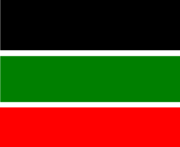
Nord-Est Departmental Flag
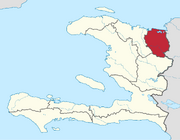
Location in Haiti
Nord-Est (English: North-East) is one of the ten departments of Haiti. It has an area of 1,805 km². Its capital is Fort-Liberté. It borders the Dominican Republic to the east.

Woman healing in Nord-Est
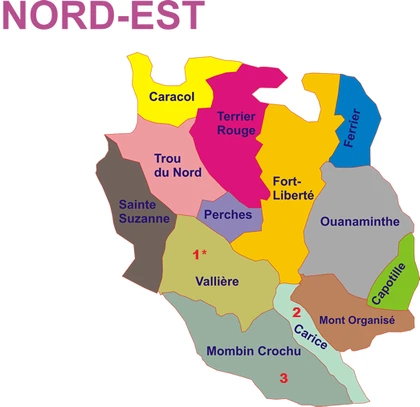
Nord-Est town locator map
Exterior boundaries
North: Atlantic Ocean
East: Dajabón and Monte Cristi Provinces, DR
South: Central Department
West: Northern Department
Interior boundaries
The department is divided in 4 arrondissements:
- Fort-Liberté Arrondissement☆
- Ouanaminthe Arrondissement
- Trou-du-Nord Arrondissement
- Vallières Arrondissement
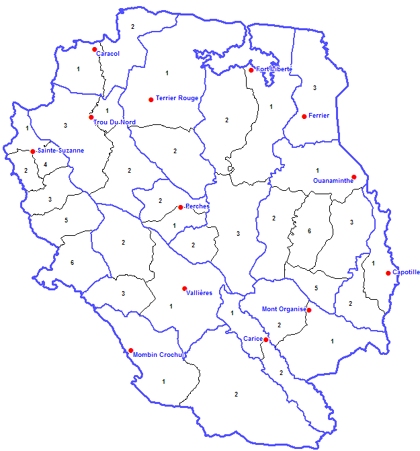
Communal map
About[]
The Northeast department is one of the 10 departments of Haiti.
The Northeast is often discussed in parallel with the Northern Department which is understandable given that the Northeast was administratively divided apart from the North relatively recently, in 1971. The North department’s capital, Cap-Haïtien, is also the second largest city in Haiti and a hub of economic and cultural activity the importance of which trickles over to the Northeast. The North-East thus finds itself often paired with the North. Here too we begin our look of the Northeast within the larger context of Northern Haiti.
In the last decade, Northern Haiti has gained significant economic momentum.
Other advances are regional, such as the national highway #6 (a 2008 European-Union funded project) that now efficiently connects Cap-Haitien to Ouanaminthe and the municipalities and districts of Trou-du-Nord, Caracol and Fort-Liberté.
The availability of electricity in certain districts of the North-East has improved drastically, largely due to the Caracol Industrial Park (CIP).
There are several large-scale investment projects of note such as the 1,000 hectare banana-plantain plantation known as Agritrans, and the USAID funded "Feed the Future" program investing approximately $88 million USD in the modernization of agriculture in the region. One of Haiti’s main exports at this time is apparel and the textile industry is certainly visible in the North-East. The Caracol Industrial Park now joins the CODEVI park, together maximizing on the trade preferences extended to Haitian manufactured apparel and the abundance of casual and cheap labor in the region.
The two industrial parks currently employ about 13,000 local workers in textile and garment production. Meanwhile, next door in the North department, the Cap-Haitien airport has recently been adapted and expanded to accommodate international flights, providing Haiti with a second international airport after Port-au-Prince.
Also, in 2012, a $30 million USD project financed by the Dominican Republic, instigated what is considered to be the most modern university of Haiti, the campus of the Roi Henri Christophe University in Limonade.
All of these factors, both structural and in terms of the scale, importance and diversity of the ongoing projects, have greatly affected development in Northern Haiti (and so too in the North-East). An important flow of activity and investment now runs through Northern Haiti; this crucial artery connecting Cap-Haitien to Ouanaminthe is known as the Northeast Corridor. A large part of the corridor is in the Northeast Department.
Nevertheless, it is easy to overlook the Northeast as the go-through department; one can easily move from busy Cap-Haitien to the Dominican border and pay little attention to what lies in between.
While the North-East certainly draws momentum from its neighbors, it is still distinctly its own department and there is a unique context to be discovered here.
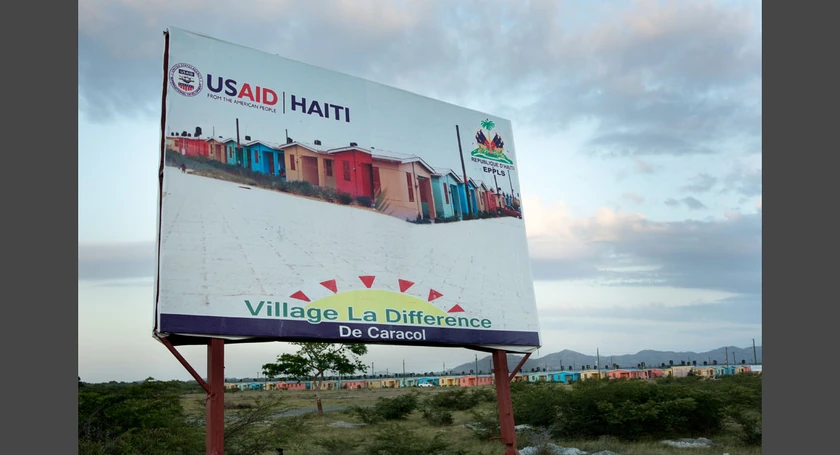
Billboard in the North East Department with new homes construction in the background.
History[]
The capital of the Northeast Department is Fort-Liberté; four (4) arrondissements, thirteen (13) communes and thirty six (36) communal sections form the administrative units of this department.
Apart from the commune of Ouanaminthe which is of Indian origin, one of its cities (Fort-Liberté) was founded in the sixteenth century, another (Caracol) in the twelfth century, (Perches, North Hole, Terrier Rouge and Vallières) in the 18th century, another (Mombin Crochu) in the 19th century, (Ferrier and Mont-Organize) in the twentieth century and the others have an unspecified period.
In the codification system, currently in force at the Haitian Institute of Statistics and Informatics, the Northeastern Department has 9 of 13 communes of this department are interior, two are coastal and the others are border towns. The relief of the department of Nord-Est is either the mountains or the plain following the municipality considered. Its climate varies from hot to cool according to the period. The Northeast has an area of 1804.28 km2 or 6.5% about the national territory.
In 1998, its population was estimated at 258,907 natives and in 2004, nearly 280,000 inhabitants.
The most populated commune of this department is Ouanaminthe.
The highest density was recorded in this municipality with 241 inhabitants / km2 and the lowest in Caracol (65habitants / km2).
Economy[]
In the fields of cultural and natural heritage, local agriculture, small industry and crafts, technicians from the Ministry of Trade and Industry have identified, in the 12 municipalities of the department of North-East, more than thirty products that constitute the economic potential of this department.
The municipality of Mont-Organisé has no sector with economic potential to be valued and the communes of Sainte-Suzanne, Caracol, Trou-du-Nord, Terrier-Rouge and Perches each have a typical product that can be put in value, all drawn from the field of cultural and natural heritage.
At Terrier-Rouge, the only product to be developed is the Morne Verron, which contains a gold deposit that has remained unexploited in the region. The stone, called Indian stone, dating from the Indian period and which is part of the monuments of the Sainte-Suzanne region, is the product that can be marketed in this town.
In Perches, Dimikalen is the product identified for use in pedestrian and equestrian activities.
The debris of the Santa Maria, supposed remains of the largest caravel led by Christopher Columbus, are qualified as the only typical product to market in Caracol.
The town of Vallière has two typical products with high potential. Fort Salnave, which is a historical monument of the area built after independence, and the River Terne are the two products (cultural and natural heritage) to be valued in this municipality.
The municipality of Capotille also contains, according to the document of the Ministry of Trade and Industry, two typical products that can be highlighted. The two waterfalls in the area: Jose waterfall and Cana waterfall.
In Ouanaminthe, the MCI document identifies six products with high commercial potential. Three that are derived from local agriculture, rice, nuts and peanuts; two in the small industry, the "makout" - handmade bag used for transporting foodstuffs -, the straw hat; and the other in the field of cultural and natural heritage, the Acul-des-Pins waterfall.
In the municipality of Mombin-Crochu, six typical products have also been identified, none of which are drawn from small industry. Four are from the cultural and natural heritage - La Roche Quenched, Gramma Lake, Labé Plage and the Haut Piton range -; the other two are from local agriculture, coffee and salt.
Six cultural and natural heritage products - Habitation Philibert, Lagoon Bef, Maribaroux Disco, Marrion Beach, Lime Kiln and Phaeton Beach and Fort -; a product of local agriculture, honey and two products of small industry and crafts - mats and makout are typical products with high development potential identified in the town of Ferrier.
The county seat comprises seven products that can be developed. At Fort Liberté, there is Fort Saint Joseph, the five forts, Fort Labor and the Bay of Mancenille which are marketable in the field of cultural and natural heritage. The mango "trò dous" is the only typical product of local agriculture identified that can be highlighted. In the small industry, jam and jelly jelly can be exploited in this area.